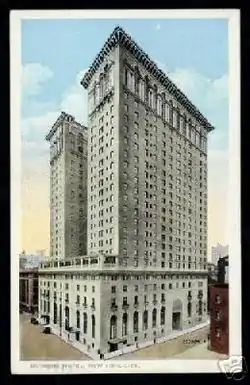New York Biltmore Hotel
The New York Biltmore Hotel was a luxury hotel in New York City that opened in 1913. It was one of three palatial hotels built as part of the Terminal City development around Grand Central Terminal in Midtown Manhattan. The others were the Commodore Hotel (currently Grand Hyatt New York), and the defunct Roosevelt Hotel. The building was gutted by developers in 1981, with predominantly its steel frame remaining. The current building has been known as Bank of America Plaza, and more recently as 335 Madison Avenue.

History
The New York Biltmore was founded by Gustav Baumann, who purchased the lease from the New York State Realty and Terminal Company, a division of the New York Central Railroad. The design was by the architectural firm of Warren and Wetmore, which also created the adjoining Grand Central Terminal. The hotel had its own arrival station within the terminal, nicknamed "The Kissing Room," with elevator access to the lobby. A private elevator served only the Presidential Suite. The Tea Room (a.k.a. Palm Court) echoed the design of the Main Concourse at the Terminal. On the 22nd floor of the hotel was the grand ballroom, called the Cascades; Bert Lown was the conductor in the hotel's early years. Between the north and south towers was the Italian Garden, which overlooked Vanderbilt Avenue and Grand Central Terminal. In the winter months the garden was transformed into an ice skating rink. Henry Ford tried to broker a truce agreement to halt World War I while headquartered at The Biltmore, 1915.
The hotel opened on New Year's Day 1913, and was operated by Baumann until his death on October 15, 1914.[1] John McEntee Bowman, the Biltmore's manager under Mr. Baumann, took control of the lease and operated the hotel thereafter.
The New York Biltmore Hotel ceased operation when the building was gutted in August 1981 by its then owners Paul Milstein and Seymour Milstein.[2] The demolition took place despite the building's landmark status and concerted protests by preservationists.[3] The hotel was stripped down to its steel structural skeleton and rebuilt as Bank of America Plaza. Though the bank is still the largest tenant, the building is today known simply by its address, 335 Madison Avenue.[4]
Grand Central Art Galleries
For 23 years the Biltmore was the home to the Grand Central Art Galleries, founded in 1922 by Walter Leighton Clark together with John Singer Sargent, Edmund Greacen, and others.[5] Originally in Grand Central Terminal, in 1958 the Galleries moved to the second floor of the Biltmore, where they had six exhibition rooms and an office.[6] The galleries remained at the Biltmore until the structure was stripped to its steel frame and converted into an office building by the Milstein Brothers.[2] The final show was "Anita Loos and Friends." Describing the end of the Biltmore and the Grand Central Art Galleries' final show there, John Russell of New York Times wrote:
"Hardly since Samson tore down the great temple at Gaza has a building disappeared as rapidly as the Biltmore Hotel. But people have shown a rare persistence this last day or two in pushing their way upstairs at the entrance on Vanderbilt Avenue to where the Grand Central Galleries has been holding its own."[7]
Role in history and popular culture
The Treaty of the Danish West Indies of 1916 was signed at the hotel, which transferred possession of the Danish West Indies, now the United States Virgin Islands, from Denmark to the United States.
The reclusive writer J. D. Salinger would meet William Shawn, the editor of The New Yorker, under the Biltmore's lobby clock.[8] It is one of many that claim to be the basis for the expression "Meet me under the clock." The office building retains the hotel's famous piano and lobby clock.
In F. Scott Fitzgerald's 1920 short story "May Day", a main character, Edith, continually asserts that she is staying at the Biltmore. Fitzgerald seems to deliberately associate the Biltmore with Jazz Age luxury and lifestyle.
In 1942, the hotel was the location of the Biltmore Conference which was a meeting of Zionist groups that produced the Biltmore Program, a series of demands regarding Palestine.
Author Frank McCourt began work in the Biltmore shortly after returning to live in New York in 1949. He recounts his experiences there in his second memoir 'Tis.
In the 1950 Broadway musical Guys and Dolls, the gamblers are desperately searching for a location for their illegal crap game. In the song "The Oldest Established (Permanent Floating Crap Game in New York)," Nicely-Nicely Johnson sings: "The Biltmore garage wants a grand [$1,000], but we ain't got a grand on hand."[9]
In the 1960s and 1970s, the Biltmore was the scene of the feminist protests. The hotel's Men's Bar, at Madison Avenue and 43rd Street, had been a male-only establishment for decades, with regulars such as New York mayor (and later governor) Al Smith. The city Human Rights Commission ordered the hotel to open the bar's doors to female patrons. It was subsequently renamed the Biltmore Bar.
See also
References
- "Gustav Baumann Falls to Death". The New York Times. October 15, 1914.
- Dunlap, David W. (August 19, 1981). "Retaining Order to Block Biltmore Demolition Expires". The New York Times.
- "Milstein Opens Throttle as Builder". The New York Times. October 18, 1981.
- Pincus, Adam (April 23, 2009). "CBRE takes over leasing at quarter-vacant 335 Madison Avenue". The Real Deal.
- "Painters and Sculptors' Gallery Association to Begin Work," New York Times, December 19, 1922
- "Galleries to End 36 Years in Depot". The New York Times. October 31, 1958.
- Russell, John (August 28, 1981). "Art: Things That Can Happen to a Print". The New York Times.
- McGrath, Charles (January 28, 2010). "J. D. Salinger, Literary Recluse, Dies at 91". The New York Times.
- "The Oldest Established", from Lyrics Mania.
Sources
- "Last Dance at The Biltmore" Article New York Magazine September 7, 1981.
- Architectural Record Volume 35 Jan-June 1914 Architectural Institute of America.
- "Mr. Baumann Falls to Death" 1914 New York Times Article Google.
- "Under the Biltmore Clock" article Life Magazine April 21, 1952 Google.
- Time /CNN archive /Google/ Business: Hotels / "United and Bowman Biltmore merger" 03/04/1929.
- On-Line News Hour with Frank McCourt March 17, 1999.
- "Biltmore Palm Court restored" New York Magazine February 17, 1975.
- Great Weekends begin in New York "Under The Clock" New York Magazine April 9, 1979.
- Landmark Group Plans uses for Biltmore Funds New York Times October 6, 1983.
- "Remembering Lunch at The Biltmore 1959" New Yorker Magazine Jan.17,2005.
- Paul Milstein dies at age 88 New York Times Obits August 9, 2010.
External links
| Wikimedia Commons has media related to New York Biltmore Hotel. |

